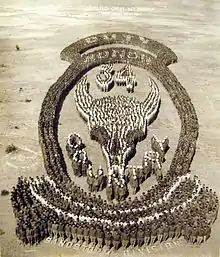Camp Cody (military camp)
Camp Cody, located on the northwest side of Deming, New Mexico, was a World War I Army camp from 1916 to 1919.

History
During World War I, Camp Cody was an army training camp for the National Guard units from North and South Dakota, Nebraska, Minnesota, and Iowa. Soldiers received basic training there before leaving for the war in France. The different National Guard units together formed the 34th Infantry Division and were nicknamed the "Sandstorm Division," a name based on the camp's desert climate. Camp Cody was also built because of the threat of Mexican intervention in the first World War.
Construction
The camp was constructed during the summer of 1917 by the government. Unable to accommodate the 30,000 troops that served at the camp it was necessary to build 120 mess houses and 1,200 bathhouses. Each regiment had its own office building and it took 11 large warehouse to store all the supplies needed for the Division. A large hospital was needed and stayed in use long after the war ended. June 14, 1918, Hughes Co. (Oklahoma) Men Called To the Colors. Call No. 607 for 113 recruits to entrain from Hughes county for Camp Cody, Deming, New Mexico, between the 24th and 29 June. The following are the names and addresses of those called. Olen Ashby, Holdenville, E. F. McKinney, Dustin, Raymond Sieminshie, Stuart, C. E. Dewitt, Holdonville, Clarence Spruell, Holdenville, Earl Crane, Stuart, Daniel A. Johnson, Holdenville, William N. Stanfill, Wetumka, Albert Annis, Wetumka, Charles W. Stanfill, Wetumka, Rufus Garland, Wetumka, Leftric Perry, Holdenville, Tom Sanders, Holderville, R. B. White, Dustin.
World War One
During the US-Mexican Border War the camp was named "Camp Brooks". Then with the beginning of the First World War it was renamed "Camp Deming". The camp was renamed again shortly after the death of the famous buffalo hunter and showman, William F. Cody (1846–1917), better known as "Buffalo Bill Cody." The camp was open from July 16, 1916, until the early months of 1919.
 Camp Cody, New Mexico, June 1918.
Camp Cody, New Mexico, June 1918.